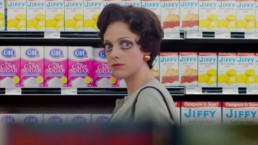Review: ‘Big Eyes’
Tim Burton's 50s-set art-dupe romp features Christoph Waltz and Amy Adams as the real life Walter and Margaret Keane.
People are strange- you’re either strange for acknowledging your intrinsic weirdness, which runs directly opposite to that of the social norm’s flow, or by failing to acknowledge it; and it always falls between those two parameters. And although pop-goth movie director Tim Burton is revered by this modern culture for making Halloween-hip horror flicks for outsider-teens, his latest movie, Big Eyes, is weird- and for reasons beyond the director’s intentions or control.
Following his most recent live-action Johnny Depp-starrer Dark Shadows (2012), Burton side steps the re-make game but keeps the swinging-sixties cool in bringing this real-life story of American painters Walter and Margaret Keane to the big screen. Their shared story, of how together they duped the art world at large into believing that Margaret’s non-anachronistic paintings of portraits with hauntingly bulging eyes were envisioned and made by her fraud of a husband, is already so wild and out there that it feels like prime fodder for Burton to dismantle and reconfigure as a delicious piece of absurdist art. The weird thing is, he doesn’t here, and it’s ultimately just no fun at all.
Again- people are weird for either being weird, or failing to acknowledge, or rather, suppressing, their weirdness (much like Margaret Keane herself). Unfortunately, Burton and his much too reined-in drippingly spooky vision are guilty of the second crime. While it might be understandable for one to reason that the director perhaps felt an urge to re-connect to his filmmaker roots, as a storyteller telling a more human story instead of being a pop-culture synthesizer playing dress-up, the film feels controlled to the point of smothering, like a fearful parent weary of letting a child have too much fun. It’s obvious there is so much more that can, and should, be squeezed from this story and, yet, the crushing formality and control of it all crushes that story and Margaret’s fragile spirit under its helpless weight.
As much as can be expected from any of the modern-day auteur’s filmography, the entire art department is fully realized and makes for the film’s most watchable element. The quick flight through 1950’s suburban-ism into the San Francisco art-cool scene, where our story is largely anchored, and through the final third act set in hula-hip Honolulu (its clunkier finale) makes for visually fun watching, but only as far as its constraint of being a biography-drama is allowed to go.
Big Eyes makes for visually fun-watching, but only as far as its constraint of being a biography-drama as is allowed to go.
Giving their most reliably great performances that they can (in the highest of praises) are the film’s stars, Amy Adams as the soft-spoken but true cartoon-eyes painting artist and Christoph Waltz, as her even more cartoonish husband (in wonderfully wild-dog Waltz fashion). Adams portrays Margaret as the naive and recently separated single mother (in a time that was not “of the times” to be) whose meekness fails to get her paintings recognized with such solemn and inner-poise, that it’s a shame it wasn’t figured out how to show her bumbling awkwardness with any higher entertainment value. It’s Waltz who has the most fun here, allowed to broad stroke his mischievous no-goodery across the entire canvas, and it’s also what gives the movie any life at all.
The film has been compared to and reminiscent of Burton’s earlier starting places, including 1994’s Ed Wood, for how it made its real-life subject and story a fun ride-along, where the audience felt apart of the world and the hi-jinks. The camera here feels uninspired, framing Margaret and Walter with the same non-commitment and treatment. Where we should’ve been riding shotgun in this art-caper romp, we are resigned to watching a story that feels like it moves on auto-pilot throughout.
There is a telling theme that runs dangerously just-below the surface and feels immediately real by the end of the film’s second act. At this point, Margaret, more quietly devastated with her agreement to sign away her entire work’s authorship than ever before, is seen pained standing in the art galleries watching the Cheshire cat grinning Walter soak up the fame, having found success with his idea of selling run-off screen prints of the paintings, posters of the big-eyed wonders for the masses to enjoy. A tiny thread runs through this idea, and is only barely bolstered by cameo art gallery owner Ruben (Jason Schwartzman) and critic John Canaday (Terrence Stamp) who, seeing the commercialization and accessibility of the work (where pop-artist Andy Warhol would completely take this over), scoff at pointing out that Keane’s work is nothing more than “kitsch,” for which art-critics must exist- to warn and protect the public from misinterpreting art from product. In Walter Keane’s fuming offense-taking, there seems to be a quiet acknowledgment that Burton’s own brand of work, in this cultural landscape, falls slightly in this commercialized kitsch for the masses. And the fact that his latest film feels directed out of fear of falling into those pitfalls and trappings, is, weirdly enough, not so weird.
Ryan Rojas
Ryan is the editorial manager of Cinemacy, which he co-runs with his older sister, Morgan. Ryan is a member of the Hollywood Critics Association. Ryan's favorite films include 2001: A Space Odyssey, The Social Network, and The Master.

